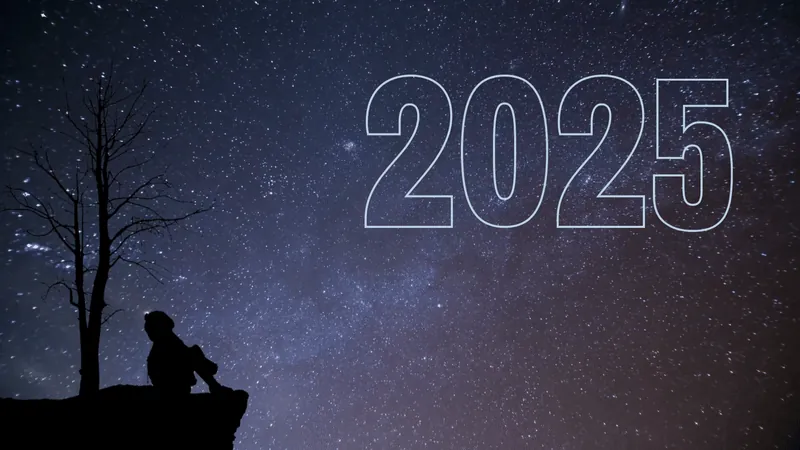
15 Celestial Spectacles to Experience with the Naked Eye in 2025!
2024-12-29
Author: Jessica Wong
Get ready, stargazers! The year 2025 promises an exhilarating lineup of celestial events that will have both seasoned astronomers and curious novices alike looking up at the night sky in awe. From breathtaking meteor showers to striking planetary alignments, there's something magical to witness every month. Below are the 15 must-see events that should be marked on your calendars.
1. Quadrantid Meteor Shower: Jan. 3, 2025 (around midnight)
Brace yourself for a sky full of shooting stars! The Quadrantids might be overlooked in winter, but they can deliver up to 120 meteors per hour at peak times. With a moonless night in January, expect brilliant fireballs to illuminate the dark sky, making it a perfect time for some late-night skywatching.
2. Mars Occulted by the Wolf Moon: Jan. 13-14, 2025 (before midnight)
Witness a captivating sight as Mars moves out of sight behind the almost full Wolf Moon. North America has the ultimate viewing advantage, with the exact timings varying by location. In Washington, D.C., watch as Mars disappears at 9:16 PM EST and reappears at 10:31 PM EST!
3. Mars at Opposition: Jan. 15, 2025 (all night)
Just after its disappearance, Mars reaches opposition, making it bigger and brighter than ever. This phenomenon occurs only once every 26 months, so take advantage of the next few weeks of prime viewing!
4. Crescent Venus at Its Brightest: Feb. 19, 2025 (after sunset)
On this day, Venus will shine in its slimmest crescent. The “Evening Star” will be at its closest approach to Earth, dazzling those who gaze upon it. Although it's a good time for telescopic viewing, don't miss it with the naked eye!
5. "Devil's Horns" Solar Eclipse: March 29, 2025 (sunrise)
Early risers will be treated to a captivating partial solar eclipse as the sun rises in North America. Perfect for those in Atlantic Canada and northeastern U.S., this unique formation will create a crescent shape on the horizon.
6. Lyrid Meteor Shower: April 21-22, 2025 (midnight)
Clear skies and ideal conditions will make for a spectacular show. With around 10 to 20 meteors per hour, this meteor shower brings the possibility of gorgeous fireballs and bright streaks across the sky.
7. Eta Aquarid Meteor Shower: May 6-7, 2025 (midnight)
Although best viewed from the Southern Hemisphere, the Eta Aquarids will grace the northern skies too—expect to see around 60 shooting stars per hour during its peak!
8. Crescent Moon Visits the Pleiades: July 20, 2025 (before sunrise)
The celestial pairing of a waning crescent moon and the beautiful Pleiades star cluster will make for a stunning sight in the early hours. It's a must-see for photographers and sky enthusiasts alike!
9. Delta Aquariid Meteor Shower: July 28-29, 2025 (after dark)
With a waning crescent moon out of the way, the Delta Aquariids can be observed clearly. This shower, known for lasting throughout the late summer, will gift viewers with around 20 meteors per hour.
10. Conjunction of Venus and Jupiter: Aug. 12, 2025 (before sunrise)
The morning sky will feature a dazzling display as Jupiter and Venus align, appearing almost as a single bright point! Don’t let the moonlight from the Perseid meteor shower overshadow this beautiful celestial event.
11. Second Partial Solar Eclipse: Sept. 21, 2025 (daytime)
New Zealand will experience a striking partial eclipse, with up to 73% of the sun obscured by the moon. This event promises to be quite the feast for the eyes, especially for our friends down under!
12. Saturn at Opposition: Sept. 21, 2025 (all night)
At its brightest, Saturn will make for a wonderful viewing opportunity. Despite 2025 being a less spectacular year for Saturn's rings, grab your telescope to appreciate the ringed planet while it’s shining brightly.




 Brasil (PT)
Brasil (PT)
 Canada (EN)
Canada (EN)
 Chile (ES)
Chile (ES)
 Česko (CS)
Česko (CS)
 대한민국 (KO)
대한민국 (KO)
 España (ES)
España (ES)
 France (FR)
France (FR)
 Hong Kong (EN)
Hong Kong (EN)
 Italia (IT)
Italia (IT)
 日本 (JA)
日本 (JA)
 Magyarország (HU)
Magyarország (HU)
 Norge (NO)
Norge (NO)
 Polska (PL)
Polska (PL)
 Schweiz (DE)
Schweiz (DE)
 Singapore (EN)
Singapore (EN)
 Sverige (SV)
Sverige (SV)
 Suomi (FI)
Suomi (FI)
 Türkiye (TR)
Türkiye (TR)